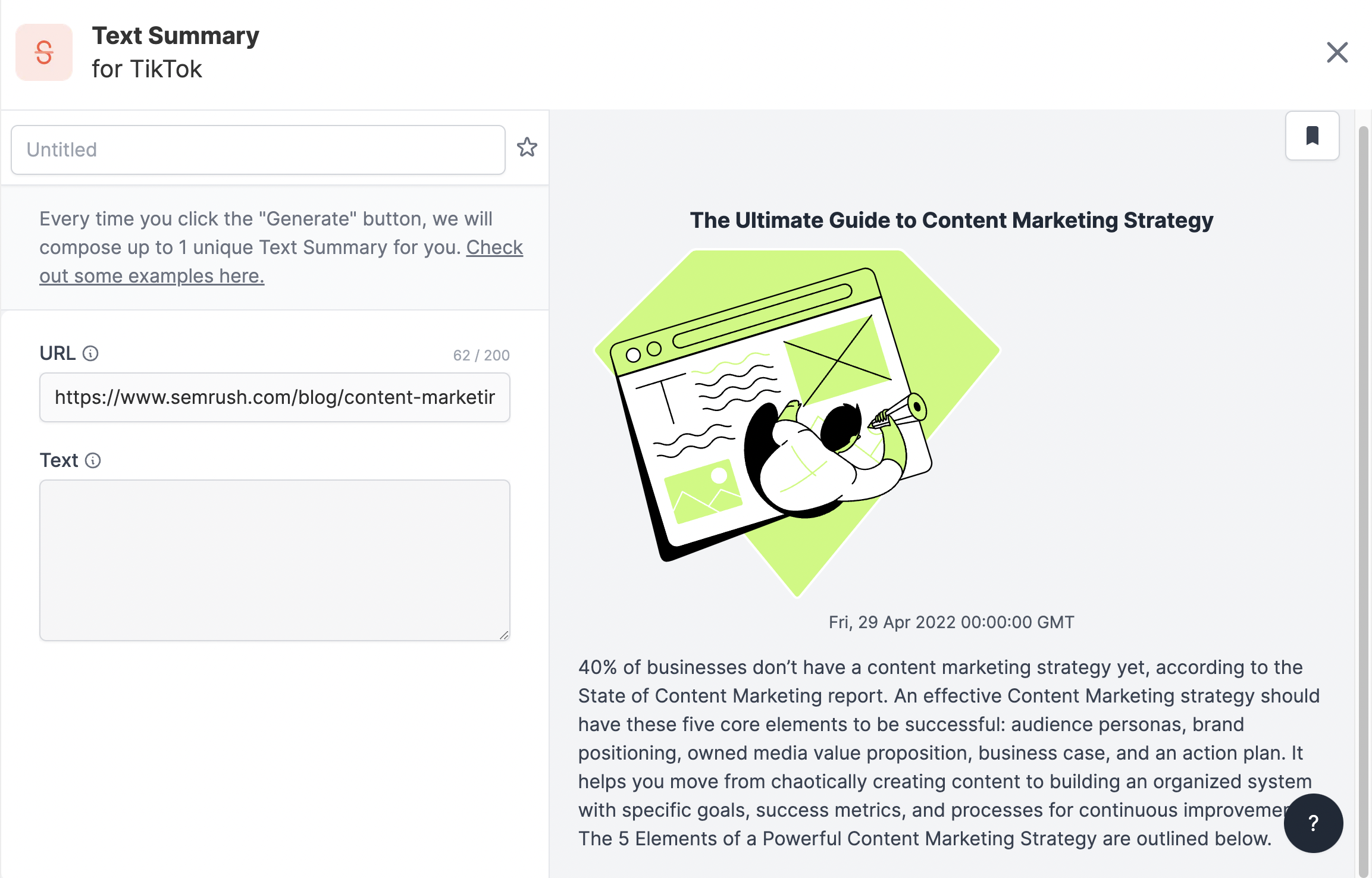Text Summary
Shortened text copy that provides the main ideas and most important details of your original text
What is a Text Summary?
Sometimes all you need is a gist of a 2000-word blog without having to read the entire post. Sometimes, it’s 5000 words, sometimes even more!
To save your time and help you get the most out of your reading material, here’s an AI writer at your disposal: TEXT SUMMARY Generator.
How to use Text Summary?
STEP 1 - Paste the URL if the content is published online.

STEP 2 - Or write the content you want to expand in the box.

STEP 3 - Click “Generate Summary”

You will get a paragraph that summarizes everything.

Here are a couple of examples:
Example 1
InputURL - https://www.semrush.com/blog/content-marketing-strategy-guide/
Language - English
Outputs40% of businesses don’t have a content marketing strategy yet, according to the State of Content Marketing report. An effective Content Marketing strategy should have these five core elements to be successful: audience personas, brand positioning, owned media value proposition, business case, and an action plan. It helps you move from chaotically creating content to building an organized system with specific goals, success metrics, and processes for continuous improvement. The 5 Elements of a Powerful Content Marketing Strategy are outlined below.
Example 2
InputText - More productive and resilient agriculture requires a major shift in the way water, soil, nutrients, and other agricultural resources are managed. Isotopic techniques can track and quantify carbon, water, and nutrient movement and their dynamics under diverse agroecosystems to improve smart agricultural practices.
Farmers need help to develop climate-smart agricultural practices that can adapt to and mitigate the impacts of climate change, but also have the potential to increase food production. Natural resources, such as land, water, soil, and genetic resources, must be better managed so that more productive and resilient agriculture can be achieved. This should include such practices as conservation agriculture, which can yield many positive benefits: reduced soil erosion; better soil water retention and nutrient availability for crops; increased soil organic matter accumulation; and higher crop and animal productivity.
Together with the FAO, the IAEA aims to optimize and strengthen the capacities of Member States in using nuclear and isotopic techniques for more climate-smart agricultural practices, while supporting a more intensified crop production and better preservation of natural resources.
Climate-smart agricultural practices can help substantially reduce greenhouse gas emissions from livestock. Often, such practices provide benefits to farm economics and the environment alike. For example, better quality feed and feed balancing not only lower intestinal and manure greenhouse gas emissions but also help increase productivity and thereby income. Improved breeding and animal health practices help reduce breeding overheads (animals assigned for breeding that are not yet producing though they are consuming resources) and related emissions.
Dual-purpose farming by smallholders with livestock that yield both meat and milk emits fewer emissions than those produced by specialized, separate beef and dairy farming. Genetic characterization and marker-assisted breeding and improved feeding can help improve meat quality and quantity from dairy animals.
How nuclear and isotopic techniques contribute
Nitrogen-15 and carbon-13 are used to track carbon, water, and nutrient movement and dynamics in agroecosystems to assess the effects of conservation agriculture measures, ascertain stabilization and turnover of soil organic matter, and determine the fate of nitrogen and carbon in crop residues. They are used to study land degradation and soil erosion, so that appropriate soil and water conservation and management practices can be effectively targeted.
Incorporation in rumen (the first division of the stomach of a ruminant animal, such as cattle) microorganisms of nitrogen-14, phosphorus-32, phosphorus-33 or sulphur-35 is used to study the uptake and utilization of rumen microbial protein, and to identify better fodder crops. This can help improve feed conversion rates and energy utilization and thereby reduce greenhouse gases.Iodine-125 labeled progesterone in radioimmunoassay (a method for measuring very small amounts of a hormone in the blood) is used to identify pregnant livestock and optimize animal breeding programs.
Radiation hybrid mapping involving cobalt-60 contributes to characterizing livestock genomes, which helps identify advantageous gene traits, such as those responsible for disease resistance or the ability to thrive under climatic or nutritional stress.
Fallout radionuclides, such as cesium-137, lead-210, and beryllium-7, are used to determine soil redistribution over different time periods, ranging from a few days (Be-7), through decades (Cs-137), to around 100 years (lead-210). This is useful to detect trends in soil erosion and sedimentation rates.
Language - English
OutputThere's a wide variety of sushi styles and presentations; however, the fundamental ingredient is sushi rice, also known as sumeshi or shari. Sushi is a Japanese dish made with vinegar-treated rice, usually with salt and sugar, along with seafood and vegetables. Sushi rice is the key element. Because it includes a wide variety of ingredients, sushi can be served in many different ways. For example, nigiri sushi is a popular kind of sushi that features a ball of sushi rice topped with a bite of fresh fish, while maki sushi is sushi that is rolled up into a cylindrical shape.
Example 3
InputURL - https://www.rts.com/blog/the-complete-plastics-recycling-process-rts/
Language - English
OutputsIn 70 years, there have been 8.3 billion metric tons of plastic produced. Only 9% of that plastic waste has been recycled. The process of plastic recycling has seen a massive improvement in recent years. There is a lack of knowledge on how to do it effectively and the process can be broken down into six basic steps. The first step in the mechanical recycling process is the collection of post-consumer materials from homes, businesses, and institutions. This can be done by either local government or private companies, with the latter often a popular option for businesses.
Tips for using Text Summary:
- If you want a much more detailed explanation, try generating a summary of one paragraph at once.
- You can use this for long-form reports and articles.
Tired of reading long-form content? Read the text summary with a click.
Updated 10 months ago
